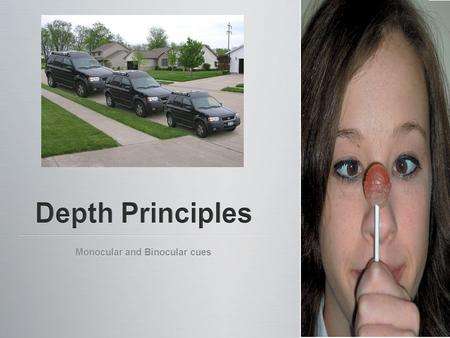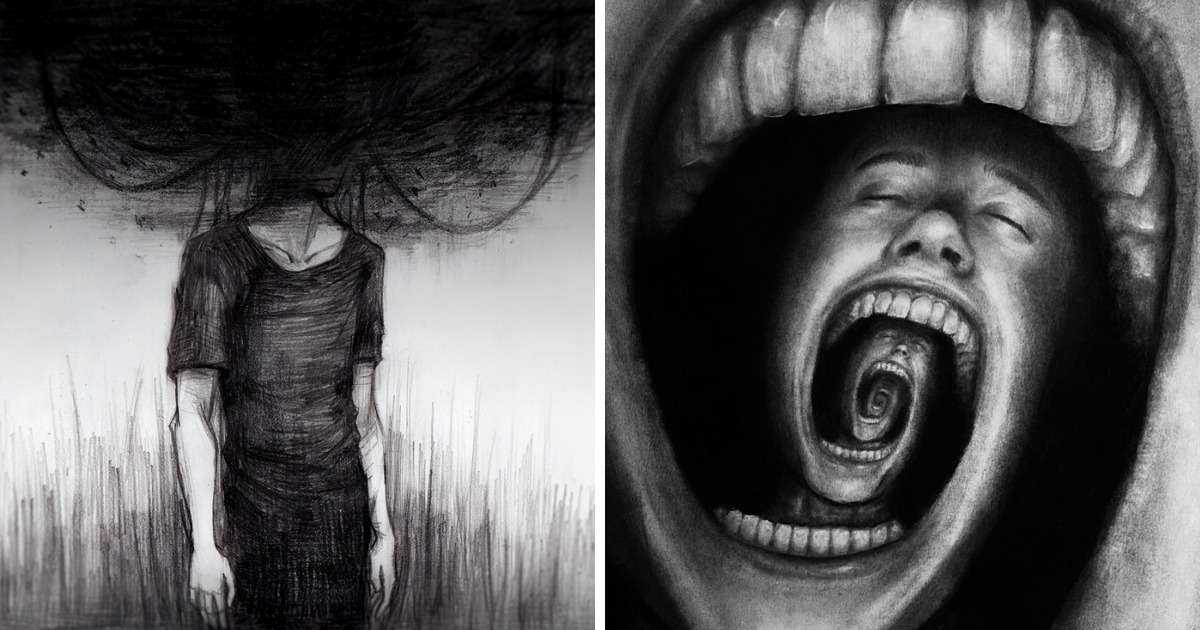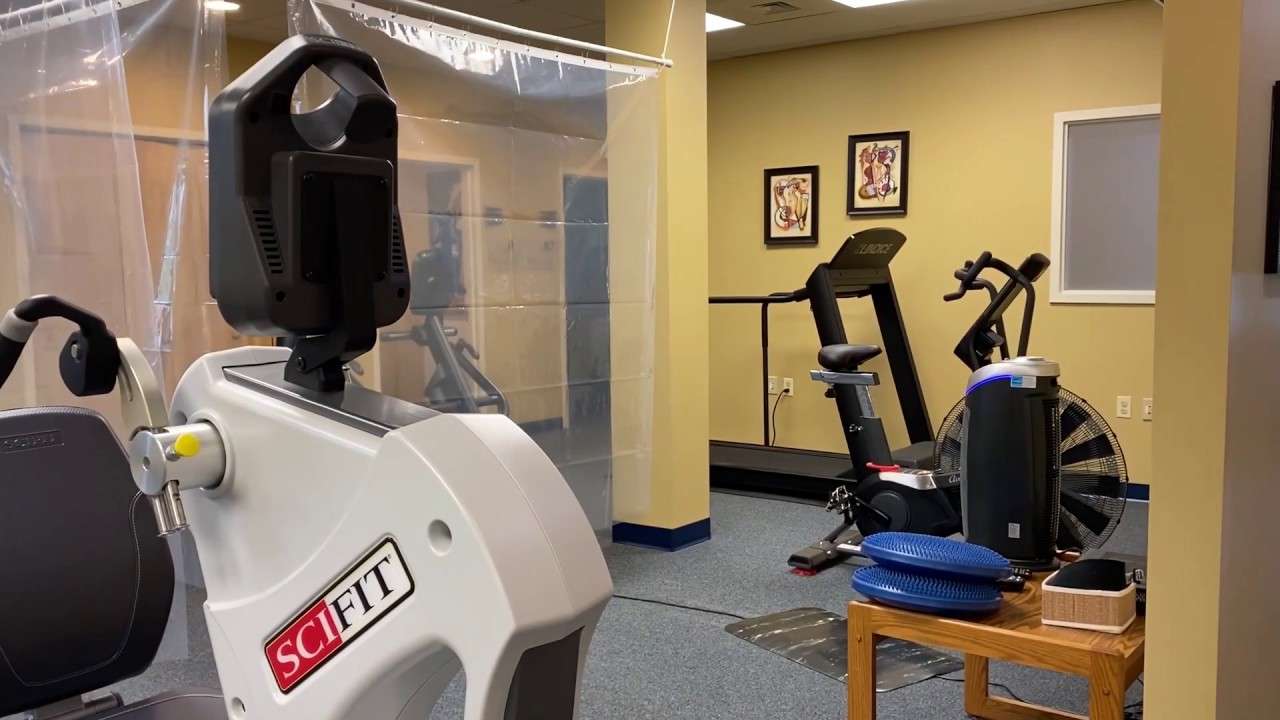Presentation on theme: “Depth Perception – Monocular and Binocular Depth cues”— Presentation transcript:
1 Depth Perception – Monocular and Binocular Depth cues
Unit 1 Psychology 
2 Depth Perception Depth perception involves interpretation of visual cues that indicate how near or far away objects are. To make judgements of distance people rely on quite a variety of clues which can be classified into two types: binocular and monocular cues. 
3 Types of Depth Clues Binocular Monocular Retinal Disparity
Accommodation Convergence Pictorial Depth Cues 
4 
5 Example: Viewmaster/Stereomaster toy
Binocular Cues Binocular Depth cues are clues about distance based on the differing views of two eyes Example: Viewmaster/Stereomaster toy 
6 Monocular Cues Monocular depth cues are clues about distance based on the image in either eye alone 
7 When do we use these cues?
When something is far from us, we rely on monocular cues, those that require the use of only one eye. For closer objects, we use both monocular cues and binocular cues, those that necessitate both eyes. 
8 Binocular Monocular Retinal Disparity Accommodation Convergence
Pictorial Depth Cues Pictorial Depth Cues Include: Linear Perspective Interposition Height in the visual field Texture Gradient Relative Size 
9 Monocular cues include: Accommodation and Pictorial Cues
Accommodation occurs when the curvature of the lens adjusts to alter visual focus. When you focus on a close object, the lens of your eye gets fatter (rounder) in order to give you a clear image. When you focus on distant objects, the lens flattens out to give you a better image of them WATCH THE VIDEO (available on Wikispace) 
10 
11 There is 5 pictorial depth cues – they include:
It is a monocular depth cue Pictorial cues are so named because artists use them to create depth and distance on two-dimensional surfaces such as paper and canvas. There is 5 pictorial depth cues – they include: 
12 1. Linear Perspective Parallel lines that run away from the viewer seem to get closer together Linear perspective is the apparent convergence of parallel lines as they recede (‘go back’) in distance 
13 
14 The shapes of near objects overlap or mask those of more distant ones
2. Interposition Also called overlap, occurs when one object partially blocked object is perceived as further away than the objects that obscures it (and vice versa) The shapes of near objects overlap or mask those of more distant ones 
15 Because of interposition you can see that this little character is in front of his parents 
16 3. Texture Gradient As distance increases, a texture gradually becomes denser and less distinct Texture gradient refers to the gradual reduction of detail that occurs in a surface as it recedes into the distance, compared with a surface that is close and perceived in fine detail 
17 Example of Texture Gradient
Look at the tiles and buildings 
18 4. Relative Size If separate objects are supposed to be of the same size, the larger ones are seen as closer Refers to the tendency to visually perceive the object that produces the largest image on the retina as being closer, and the object that produces the smallest image to be further away. The objects being perceived must be expected to be about the same size in real life. 
19 Because of Height in the visual field, you will recognise that the people closer to the horizon are further away, and things further from the horizon are closer to you (i.e. the hand and arm) 
20 As a class point out where the pictorial depth cues are for the pictures on the following slides
Write in Textbook: Linear Perspective Interposition Height in the visual field Texture Gradient Relative Size 
21 
22 
23 Your Task Use the 5 pictorial cues you have just learned to discuss a photo Do one or more and please 
-
Depth Perception Eric Thomas Psychology 159
-
DEPTH PERCEPTION • Why have depth perception? • Why is depth perception difficult? • How do we see depth? • Size – distance scaling
-
Why have depth perception? • Detection • Discrimination • Identification
-
Why is depth perception difficult? • The world is three-dimensional • Our initial visual representation is two dimensional • Somehow, we need to recover the third dimension (depth)
-
How do we see depth? • Oculomotor and visual cues help us solve the problem. • Sources of depth information • Oculomotor • Convergence • Accomodation
-
Visual • Binocular • Monocular • Moving (motion parallax) • Static (pictorial) • occlusion • ariel (atmospheric) perspective • linear perspective • texture • shading • size
-
Oculomotor depth cues • Convergence • You converge your eyes when looking at close objects you diverge to look at distant objects
-
Accomodation • You accomodate more to focus on closer objects • The amount of convergence and accomodation can be used as cues for absolute depth (for objects not too far away from you)
-
Binocular visual fields • To make use of binocular depth cues, an organism must have a binocular visual field — a region of overlapping visibility for the two eyes. • Different animals have different extents of binocular visual fields. In general, predators have both eyes on the front of their heads, and consequently have large binocular visual fields. In contrast, prey typically have one eye on either side of their heads, and consequently have small, if any, binocular visual fields. The relevance of this predator/prey distinction will become apparent soon…
-
Retinal disparity • Although humans have large binocular visual fields, each eye is getting a slightly different view of the world because the two eyes are in slightly different positions. • Retinal disparity is the difference between the lateral position of object in the left and right eyes
-
These images illustrate how the same scene might look to the left and the right eyes. Notice that objects are different distances from one another in the two pictures. The difference in the lateral positions of an object in the left and right eyes’ image defines the retinal disparity for that object. The disparity in this scene is particularly easy to see in the arrangement of the champagne glasses and pointing hand on the right side of each scene.
-
Depends on relative distance (relative to the point of fixation) • Gives us two pieces of information • Sign • Farther than fixation -> uncrossed disparity • Closer than fixation -> crossed disparity • Magnitude • Large difference in depth -> large disparity • Small difference in depth -> small disparity
-
Can there be zero disparity? • YES! • Horopter: imaginary plane where each object on the plane casts images on corresponding parts of both eyes. Includes the point of fixation. • Objects same distance from observer as fixation yield zero disparity • Objects on the horopter cast images on corresponding points of both eyes
-
In this picture, the lifeguard is fixating on Ralph. The curved, dashed line represents the horopter: all points on this line are the same distance from the lifeguard as the fixation point. So, Susan and Harry (and Ralph) fall on the horopter; Carol and Charlie do not.
-
The red, green, and blue lines show where the images of Susan, Ralph, and Harry, respectively, are cast on the retinae of the two eyes. Using point F/F’ as a reference (the foveae for the left and right eyes, respectively), you can see that the image of Susan falls on the same point on both eyes. In other words, A is the same distance to the left of F (left eye) as A’ is from F’ (right eye). Similarly, the image of Harry falls on the same point in both eyes (G is the same distance to the right of F, as G’ is from F’). Because the images of these objects (Susan, Ralph, and Harry) fall on the same positions in both eyes, there is ZERO disparity. All objects will be perceived as being the same distance from the observer.
-
What does disparity DO for us? • Disparity is a geometric fact — resulting from the fact that both eyes get slightly different views of the world. The visual system uses disparity information as one cue to depth; disparity gives us stereopsis (from the Greek meaning solid sight). • The fact that a three-dimesional percept can be derived from retinal disparity is seen when we view stereograms: displays in which each eye receives a slightly different picture/view. In the 1830s, Wheatstone developed a device with which to view stereograms: the stereoscope. This device presented one two-dimsensional view of a scene to one eye, and a slightly different two-dimensional view to the other eye. When the brain received these slightly different views from the two eyes, it integrated them into one three-dimensional scene. In other words, the disparity between the two scenes enabled the observer to see depth.
-
Random dot stereograms • In the 1960s (~130 years after the invention of the stereoscope), Julesz developed random dot stereograms. In a random dot stereogram, each eye sees only a collection of spatially random dots. But when the information from the two eyes is combined, the observer can see depth, and the depth can define a form. In this case, then, depth perception can precede form perception.
-
In random dot stereograms, neither eye sees any clear form on its own. The percept of form follows the percept of depth. If no clear form is perceived in either monocular view, how does the visual system know which features in one eye’s view match up with which feature’s in the other eye’s view? This question is known as the correspondence problem for stereovision. Although the answer is complicated, we do know the following: • spatial frequency information plays a role in solving the correspondence problem (note: this is not to say that spatial frequency is all that matters!) • we need overlapping spatial frequency information in the two eyes to see stereo
-
Do we all have stereopsis? • NO!! There are great individual difference in stereovision abilities. Some people have no trouble fusing stereoimages, others can fuse the images with some practice, and still others can never see depth from the images no matter how long they practice. This last group of observers (5-10% of humans) is stereoblind • Stereopsis requires properly working binocular cells • Properly working binocular cells require normal visual experience • Kittens raised with only one eye open at a time do not develop normal binocular cells, even though they appear to be normal in every other respect • Humans who had abnormal early visual experiences (e.g., strabismus), often do not have stereovision. There is a critical period for the development of binocular cells (and consequently stereovision). If the problem causing abnormal early visual experience is not caught early enough, it can lead to permanent damage. • Although some people do not have stereovision, they still can see depth! They won’t be able to use the binocular depth cues, but they still can use monocular depth cues.
-
Occlusion: Closer objects partly block the view of more distant objects. • Occlusion leads to a percept of depth (you see the occluding object as closer than the occluded object). • Occlusion also enables us to complete and recognize objects. • Occlusion is closely related to other perceptual phenomena such as transparency and illusory contours.
-
Occlusion also is related to illusory contours. In each the top two figures, you see illusory shapes floating in front of four completed circles. Of course, neither the illusory shapes, nor the circles are included in the information that reaches your retina….
-
Aerial perspective: More distant objects are perceived less clearly than closer objects. • The further the light must travel to reach the eye, the more likely that light will be interfered with in some way by matter. • Aerial perspective sometimes is called atmospheric perspective because the effect is due to the atmosphere interfering with light.
-
Linear perspective: Lines that are parallel in the real world appear to converge in a drawing. • The greater the distance, the greater the convergence. • At infinity, lines meet at the vanishing point.
-
In this painting from the 16th century, the artist made use of linear perspective to indicate that the Church is somewhere in the distance. The lines of squares are parallel in the real world, so they appear to converge in this painting. Note that there is one spot in the upper left of the painting where the artist did not draw the lines converging — instead they are parallel. This lack of linear perspective makes it look as though there is an incline just to the left of the church.
-
Texture gradients: Texture is more dense in a distant object than in an identical closer object. • If there is no variation in texture density, no depth will be perceived. • An abrupt change in texture implies a depth discontinuity (a sharp bend).
-
Shading: Three-dimensional objects cast shadows, so 3D objects tend to have luminance gradients. • In perceiving depth from shading, we make certain default assumptions about lighting • There is only one light source. • Light comes from above. • “Above” is defined retinally, not environmentally (i.e., the light seems to come from the same direction as the top of your head, even when you turn your head on its side). • Some animals have evolved a camoflauge strategy called counter-shading to counteract the effects of shading. For example, fish are lighter on their undersides and darker on their top sides. This way, when light hits them from above, they’ll minimize the luminance gradient, and look as flat (and unappetizing) as possible.
-
The “direction” of depth depends on the direction of the luminance gradient. Because we assume (as the default) that there is only one light source, and that that light source is from above, if an object is brighter on the top than on the bottom, we’ll perceive that object as convex (like the “eggs” that form an X in this picture). In contrast, if the object is brighter on the bottom than on the top, we’ll perceive that object as concave (like the “holes” in this picture).
-
Size: Smaller objects often appear to be more distant than identical larger objects. • The link between size and perceived depth stems from the fact that as an object moves further away from you, it’s retinal image size decreases (and vice versa). • Two objects of different retinal image size are at the same depth only if they really differ in size.
-
MOVING • Motion Parallax • Objects at different distances from fixation move at different rates and directions on your retina. • Motion parallax can be thought of a disparity across time in contrast to the disparity across eyes seen in stereovision. • Net result is the same: by integrating information about slightly different views across time, you see depth. • Note that disparity from motion parallax is equivalent to disparity from stereopsis when the head/eye is moved the distance between the two eyes.
-
Note how the retinal positions of the objects change as the eye moves from left to right. These differences in position give disparity across time: motion parallax.
-
Perception of size and depth perception • An object can look the same size at different distances But: retinal image size changes with distance • Increase distance : decrease retinal image size • Decrease distance : increase retinal image size • The fact that an object can look the same size regardless of changing retinal image size is referred to as size constancy
-
These three disks look to be the same size, but at different depths. In fact, they vary greatly in terms of their retinal image sizes.
-
The fact that we have size constancy means that perceived size depends on more than just retinal image size. • We seem to take perceived distance into account as well. • This link between perceived size and perceived distance is known as size-distance scaling. • We can formalize the notion of size-distance scaling in terms of Emmert’s law: • Sp = k * Sr * Dp • (Sp -> perceived size; Sr-> retinal size; • Dp -> perceived distance; k -> constant)
Depth Perception. Eric Thomas Psychology 159. DEPTH PERCEPTION. Why have depth perception? Why is depth perception difficult? How do we see depth? Size – distance scaling. Why have depth perception?. Detection Discrimination Identification. Why is depth perception difficult?.
Depth – . the challenge of this class is not the length, difficulty or grammatical correctness of what we read and




